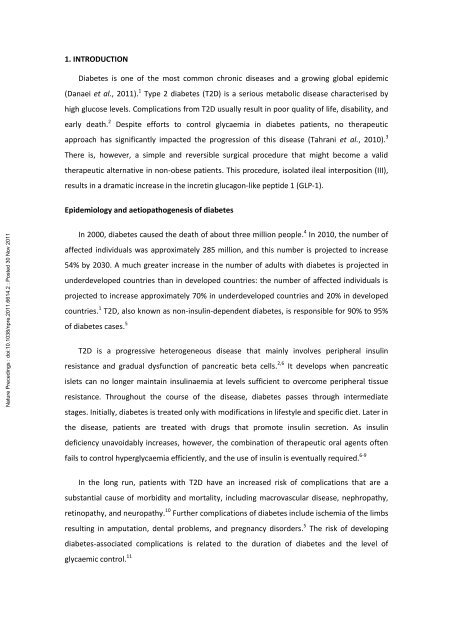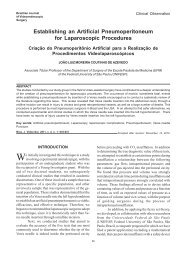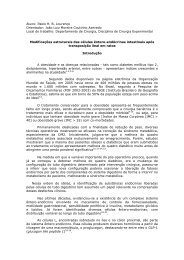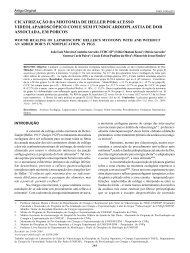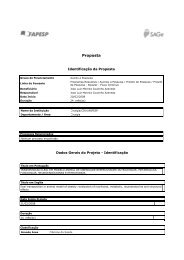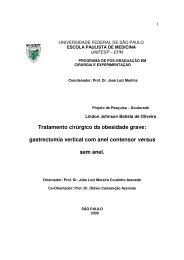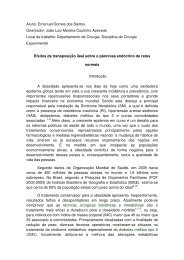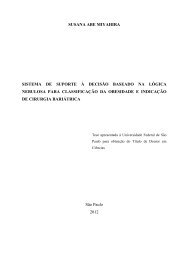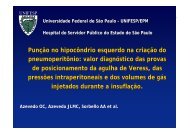Isolated ileal interposition in enteroendocrine L cells differentiation
Isolated ileal interposition in enteroendocrine L cells differentiation
Isolated ileal interposition in enteroendocrine L cells differentiation
Create successful ePaper yourself
Turn your PDF publications into a flip-book with our unique Google optimized e-Paper software.
1. INTRODUCTION<br />
Diabetes is one of the most common chronic diseases and a grow<strong>in</strong>g global epidemic<br />
(Danaei et al., 2011). 1 Type 2 diabetes (T2D) is a serious metabolic disease characterised by<br />
high glucose levels. Complications from T2D usually result <strong>in</strong> poor quality of life, disability, and<br />
early death. 2 Despite efforts to control glycaemia <strong>in</strong> diabetes patients, no therapeutic<br />
approach has significantly impacted the progression of this disease (Tahrani et al., 2010). 3<br />
There is, however, a simple and reversible surgical procedure that might become a valid<br />
therapeutic alternative <strong>in</strong> non-obese patients. This procedure, isolated <strong>ileal</strong> <strong><strong>in</strong>terposition</strong> (III),<br />
results <strong>in</strong> a dramatic <strong>in</strong>crease <strong>in</strong> the <strong>in</strong>cret<strong>in</strong> glucagon-like peptide 1 (GLP-1).<br />
Epidemiology and aetiopathogenesis of diabetes<br />
Nature Preced<strong>in</strong>gs : doi:10.1038/npre.2011.6614.2 : Posted 30 Nov 2011<br />
In 2000, diabetes caused the death of about three million people. 4 In 2010, the number of<br />
affected <strong>in</strong>dividuals was approximately 285 million, and this number is projected to <strong>in</strong>crease<br />
54% by 2030. A much greater <strong>in</strong>crease <strong>in</strong> the number of adults with diabetes is projected <strong>in</strong><br />
underdeveloped countries than <strong>in</strong> developed countries: the number of affected <strong>in</strong>dividuals is<br />
projected to <strong>in</strong>crease approximately 70% <strong>in</strong> underdeveloped countries and 20% <strong>in</strong> developed<br />
countries. 1 T2D, also known as non-<strong>in</strong>sul<strong>in</strong>-dependent diabetes, is responsible for 90% to 95%<br />
of diabetes cases. 5<br />
T2D is a progressive heterogeneous disease that ma<strong>in</strong>ly <strong>in</strong>volves peripheral <strong>in</strong>sul<strong>in</strong><br />
resistance and gradual dysfunction of pancreatic beta <strong>cells</strong>. 2,6 It develops when pancreatic<br />
islets can no longer ma<strong>in</strong>ta<strong>in</strong> <strong>in</strong>sul<strong>in</strong>aemia at levels sufficient to overcome peripheral tissue<br />
resistance. Throughout the course of the disease, diabetes passes through <strong>in</strong>termediate<br />
stages. Initially, diabetes is treated only with modifications <strong>in</strong> lifestyle and specific diet. Later <strong>in</strong><br />
the disease, patients are treated with drugs that promote <strong>in</strong>sul<strong>in</strong> secretion. As <strong>in</strong>sul<strong>in</strong><br />
deficiency unavoidably <strong>in</strong>creases, however, the comb<strong>in</strong>ation of therapeutic oral agents often<br />
fails to control hyperglycaemia efficiently, and the use of <strong>in</strong>sul<strong>in</strong> is eventually required. 6-9<br />
In the long run, patients with T2D have an <strong>in</strong>creased risk of complications that are a<br />
substantial cause of morbidity and mortality, <strong>in</strong>clud<strong>in</strong>g macrovascular disease, nephropathy,<br />
ret<strong>in</strong>opathy, and neuropathy. 10 Further complications of diabetes <strong>in</strong>clude ischemia of the limbs<br />
result<strong>in</strong>g <strong>in</strong> amputation, dental problems, and pregnancy disorders. 5 The risk of develop<strong>in</strong>g<br />
diabetes-associated complications is related to the duration of diabetes and the level of<br />
glycaemic control. 11


